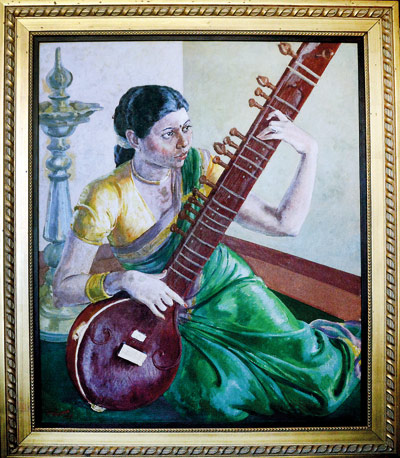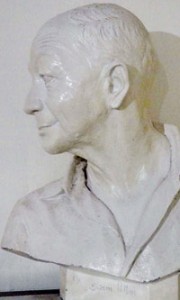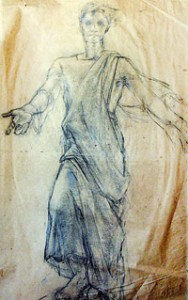News
On the trail of Paynter’s paintings; sold and regained
A respected academic in his late seventies is accused of secretly hawking to local collectors, the works of one of Sri Lanka’s greatest artists because “he needed money”.

Pictured here are some of the paintings that had been sold allegedly by Prof. Dharmasiri. Pix by Indika Handuwala
Prof. Albert Dharmasiri was granted bail by the Nuwara Eliya Magistrate this week. His arrest sent shockwaves through the country’s academic and artistic community.
The nine paintings and two drawings he is alleged to have sold off are the works of David Paynter, an artist he has written books on.
The collection is now in the custody of the Financial Crimes Investigation Division (FCID) which conducted the investigation. It will be handed over to the Faculty of Visual Arts of the University of the Visual and Performing Arts.
If due procedure is followed, the five buyers will also be asked to furnish statements. As they were in possession of stolen goods, they are not entitled to their money back.
It is learnt that some of them had paid bargain sums for the priceless pieces. They could consider civil action against Prof. Dharmasiri but there is still no indication that they would.
One of the basic rules of buying art is to look for provenance, history and documentation. These factors help determine the authenticity of a piece, complete with origin and path from the time it was produced.
In a genuine painting with clear history, it would be possible to establish who last held legal ownership—something a “bona fide” art collector or dealer would check.
Prof. Dharmasiri was in possession of a total of 19 drawings and paintings. He took them into his care in October 2010 from the Paynter Home in Nuwara Eliya.

ASP Renuka Jayasundara
The orphanage was founded in 1924 by Reverend Arnold Paynter, David’s older brother. Occasionally, a member of a visiting tour group would ask to view the collection and make a donation.
But the last will of David’s younger sister, Evangeline Darling, called for the sketches and paintings to first be put into the care of a three-member committee comprising Prof. Dharmasiri (curator), Prof. Senake Bandaranayake and Dr. A.J. Goonawardana; and then to be “exhibited in a separate room in the Department of Painting and Sculpture of the Institute of Aesthetic Studies of the University of Kelaniya”.
David Paynter left no last will. And the contents of Evangeline’s will were never properly implemented. The committee was set up.
But the sketches and paintings were not handed over to the University. Instead, Prof. Dharmasiri took them home, promising to keep them safe until a dedicated gallery was set up for them under the aegis of the University of the Visual and Performing Arts—as it is now called.
Prof. Dharmasiri gave a written agreement that he would transfer the pieces to a gallery within one year, said Angeline Jacobs, Trustee and Managing Director of the Paynter Home.
But nothing happened for nearly five years. There was no indication that the collection would ever be endowed with the Faculty of Visual Arts.
In 2014, Ms. Jacobs related the sad tale of the Paynter collection to an art student who visited the home. She brought it to the notice of Sarath Chandrajeewa, a renowned sculptor who was then the Dean of the Faculty of Visual Arts. Prof. Chandrajeewa was himself a student of Prof. Dharmasiri and did not, at first, believe it.
But the Paynter Home provided him with proof. Out of respect for his teacher, he first made friendly inquiries and tried to get hold of the paintings informally.
He failed. So he took the official route. In February 2015, he wrote to Prof. Dharmasiri in his capacity as Dean. He asked him to hand the paintings over to the Gallery of the Faculty of Visual Arts.
But he was met with resistance. Letters, including recalcitrant responses from Prof. Dharmasiri, flew up and down.
“I finally realised that he is never going to give these paintings back,” said Prof. Chandrajeewa, who is now the Dean of the Faculty of Graduate Studies of the University.
He took it to higher authorities but claims they slept on it. “They did not conduct an investigation,” he related. “Not even the internal auditors did anything.
The matter went up to the Faculty Board and the Senate. Nobody took action.”
“When students do something, they conduct inquiries,” Prof. Chandrajeewa said. “Discipline is only for small people. Not for big people.” He terminated Prof. Dharmasiri’s Faculty membership but even this was not approved.
In September, Prof. Chandrajeewa complained to the FCID with a heavy heart. “He was my best teacher,” he said. “We had a forty-year relationship as academics.
But as the Dean I had to do justice to David Paynter and Eva Darling. The paintings are a national treasure. They don’t belong to one person but to the country.”
The FCID team led by Assistant Superintendent of Police Renuka Jayasundara found that Prof. Dharmasiri had sold eleven pieces over a period of months.
The FCID made an application to the Nuwara Eliya Magistrate’s Court in this regard. The team tracked down all but one painting, including some that were in the home of Prof. Dharmasiri.
The buyers delivered their respective pieces to the FCID office in Kollupitiya. One painting, called ‘Cotton Tree in Bloom’, remains missing.
The Sunday Times contacted Prof. Dharmasiri for his side of the story. He turned down an interview on the advice of his lawyer. He is charged with breach of trust and is cooperating with police.
He was released on a cash bail of Rs. 5,000 and a surety bail of Rs. 200,000. His passport was impounded and his basnk account frozen pending further inquiries.
| Of the artist and his paintings The owner of an exclusive café, a businessman owner of a conglomerate with interest in electronic media, and an architect are among the five buyers of David Paynter’s works, Prof. Sarath Chandrajeewa told the Sunday Times. One of the purchased works was a pencil sketch of ‘Christ’s Transfiguration’ which became the foundation for a mural at S. Thomas College, Mt. Lavinia. Given the distinction of the artist, it is unsurprising that the pieces were snapped up. Paynter was born in Almora, Uttar Pradesh, India in 1900. His father was a Christian missionary in India and his mother was a Sinhalese, from Sri Lanka’s south. Paynter studied at Breeks Memorial School in Uttar Pradesh and at Trinity College, Kandy. At 19, Paynter won a scholarship to study art in the Royal Academy, London. He did further studies in Italy where he learned about Renaissance Christian art. He is famous for having painted the fabulous mural at the Trinity College Chapel while the ‘Christ’s Transfiguration’ is thought to be one of his best. He has exhibited in capitals around the world. “Very much a labour of love, those murals were,” says his sister, Eva, in the book “Paynter” written jointly with Prof. Albert Dharmasiri. “David Paynter absorbed what was of value, not only from the academic school but also from the Renaissance tradition, the Impressionists, the Post-Impressionists, Moderns and the Eastern tradition, and then proceeded to reconstruct according to his own sensitive vision,” the latter records. “Accordingly, he achieves in his work a harmonious blend of form and colour, thought and feeling, truth and beauty, the ideal and the real.” The works of Paynter that were sold and regained include “Pine”; “Mangrove”; “Sitar Player”; “The Seashore”; “Self Portrait with Lotuses”; “The Offering”; “Study for a Composition”; and “Washing of Disciples’ Feet”. Prof. Chandrajeewa said they will all be restored, preserved and displayed in a dedicated gallery within one year. He also called for the establishment of a modern art museum in Sri Lanka. |

The Paynter childrens’ home in Nuwara Eliya. Pix by Shelton Hettiarachchi

Paynter has been laid to rest in Nuwara Eliya
(Additional reporting by Nuwara Eliya Correspondent Shelton Hettiarachchi)


